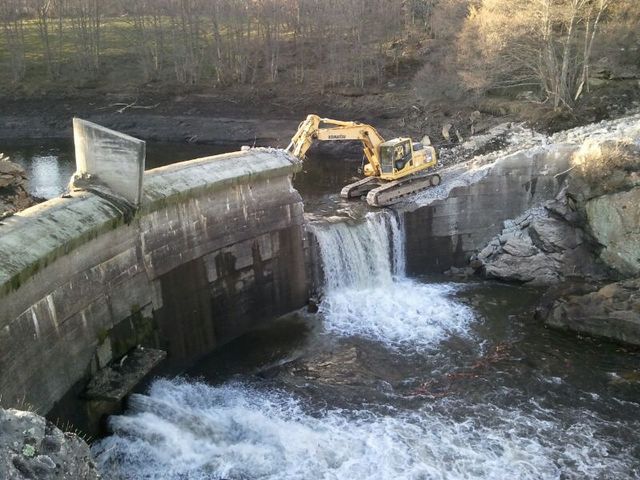Top Ten Reasons Why Dam Removal is a Great Climate Solution
 As the climate crisis escalates, a huge amount of attention and money is being focused on climate solutions that can include “mitigation”, which attempt to lower greenhouse gas emission, and “adaptation”, which includes methods to adapt to climate impacts to increase human and ecological resiliency.
As the climate crisis escalates, a huge amount of attention and money is being focused on climate solutions that can include “mitigation”, which attempt to lower greenhouse gas emission, and “adaptation”, which includes methods to adapt to climate impacts to increase human and ecological resiliency.
Missing from almost every story or study about climate solutions is how dam removal can be a key climate solution for both mitigation and adaptation. Dams, of course, block rivers and create enormous negative environmental impacts, much of which has already been described in scientific literature.
But the specific role that dam removal can play in mitigating and adapting to climate change has not been fully fleshed out. Here’s the top ten reasons why dam removal is a great climate solution:
- Dam removal is a key climate mitigation strategy because it reduces greenhouse gas emissions, especially methane. An increasing amount of scientific evidence, including from the U.S. Environmental Protection Agency, indicates that dam/reservoir systems can be significant methane emitters. In some cases, hydropower dam projects can emit as much total greenhouse gases as a coal-fired powerplant.
. - Dam removal allows rivers to meander through their historic valleys, plains, and forests. In so doing, rivers transport surrounding organic material, such as decomposed plants and soil, all the way to sea. Once at the sea, much of the material sinks to the bottom where it gets transformed and locked into rock formations. These ‘river plumes’ are carbon sinks and can extend for miles into the ocean.
. - Dam removal also allows landscapes that have been flooded to regrow their native vegetation which are carbon sinks. In the U.S. alone, the largest 150 reservoirs submerge over seven million acres of land. In the Canadian province of Quebec, over 6 million acres of previously forested land is covered by reservoirs. Globally, there are likely over a hundred million acres of land flooded by reservoirs.
. - One of most detrimental ecological impacts of climate change is that it causes a diminishment of biodiversity. Further, the construction of dams and reservoirs exacerbate this loss of biodiversity by flooding riverine ecosystems that are biodiversity hotspots. Dam removal restores native biodiversity, a key climate adaptation strategy.
. - Healthy forests – especially old growth forests – are important carbon sinks in many ecosystems of the world including the Pacific Northwest of the U.S. Dam removal that restores the migration of anadramous fish, such as wild salmon, are “fertilizers” for healthy forests as the fish swim upstream and die, replenishing the soil and ecosystem.
. - Climate change is causing rising sea levels that batter coasts and deplete beaches in California and across the planet. Because dams block natural sediment from flowing to the sea, dam removal will allow sediment to reach estuaries and coasts where it can help provide the material to rebuild beaches. Sediment in river deltas can also help protect against salt water encroachment, worsened by rising seas, in places like the Mississippi River Delta.
. - In parts of the U.S. and the world, dams have decimated fish populations that are a principle food source for local and native people. Dam removal allows fish to naturally spawn, reproduce, and migrate along vast stretches of rivers. As climate change intensifies, freshwater river fish are increasingly depended on as a human food source.
. - Reservoirs, large and small, allow vast amounts of water to evaporate off their surfaces which gets worse as temperatures rise. As just one example, in the drought- and overuse-plagued Colorado River in the Southwest U.S., it is estimated that 10% of the entire flow of the river evaporates every year. Removing dams and storing water in underground aquifers makes water supplies more resilient in an increasingly warmer world.
. - Climate change is intensifying extreme weather including rainfall, floods, and melting glaciers. Most dams, large and small, were constructed to withstand a range of weather events that may no longer be the norm. Further, dams need an increasing amount maintenance and repairs to withstand extreme floods. Recent devastating floods in Libya and India that have caused large-scale dam collapses suggest that dam removal can increase the health and safety of downstream human settlements in the path of climate change.
. - As climate change causes the planet to warm, heat waves – especially in urban areas – cause human heat stress and deaths. Not only do healthy flowing rivers provide a ‘cooling effect’ to surrounding urban heat islands, but people increasingly use local rivers to stay cool on hot days. Dam removal insures that rivers flow and stay cooler, cleaner, and healthier in a climate-changed world.
With over 80,000 dams in the U.S., and over 800,000 across the planet, it’s important to evaluate them all for removal as potential climate solutions. In many cases, both mitigation (#1 above, lowering methane emissions) and adaptation (#2 – 10 above) can be achieved in one single dam removal event. Few other climate solution projects offer this breadth and magnitude of benefits.
While most other climate solutions involve building some type of structure or facility as a technical solution, dam removal involves tearing a structure down and restoring natural ecological processes. Sometimes called a “Nature-Based Solution”, removing dams that block rivers must be considered in the vast mix of responses to the escalating climate crisis.
*****
